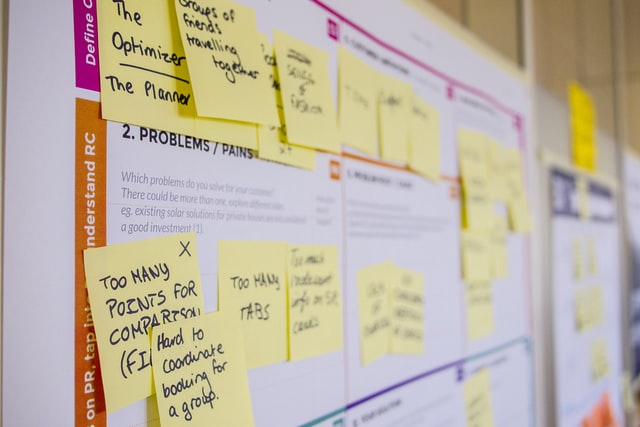Discovery, facilitation, research and results
Defining the relationship between research and facilitation within the discovery process
Fears usually arise from time of initial project idea generation to final design implementation within large scale UX+UI projects. These fears are usually around the ROI of proposed ideas; how far and how much money we spend on ideas. This is where discovery, facilitation and market research comes in to play!
There is a limit to how much we can come up with on our own. We need techniques and strategies that can help us generate ideas more effectively. That’s where faciliation comes in; guiding people to work together in a structured way and solve problems more effectively, all while creating an environment where ideas can flow and decisions feel easy. This process usually sits within the broader The goal of facilitation is to identify and analyse opportunities for enhancing a company’s offerings to it’s users, whilst understanding the technical limitations of innovation techniques and cost to impact ratio.
A large part to play in this is research. How can we begin a project and in comprehending problems a company may solve for it’s users without first gathering ideas and pulling them apart. However, research must take place in the context of the industry culture, business idea justification and competitive business strength. In this context, research methods can be used as tools to evaluate new solutions.

To research first, or to facilitate first?
One of the main pain points I’ve found in starting a new project is defining how far to go into researching before starting facilitation and idea gathering. It’s typically needed to know enough about the challenges a user group and brand face in order to propose accurate problems and solutions. But how do you get to this point without first going into facilitation?
By instead implementing customer experience strategy, brand audits and market audits as the first step, the baseline is laid to then build upon specific knowledge and ideas for the project. Often, this isn’t done in a workshop but instead in an information gathering phase which the client feeds into. It’s important at this stage not to get carried away with ideas and possibilities, as at this point there’s no way of judging if they’re feasible or within scope.
The process thereafter can then be broken up into three stages:
- defining the problem (workshopping, planning and research),
- identifying possible solutions (workshopping and research), and
- testing and refining these solutions (research, presentation and re-planning).
Research, Research
Research has the ability to help in developing innovative products that help a particular brand’s market grow. How it’s used within discovery, and fed into facilitation phases is key to getting the right results.
Mind the gap
Types of research are broad, although they vary from situation to situation. A gap analysis is a technique that is designed to identify the gap in a particular industry. This gap can be centered around certain marketing channels or licensors. An action research gap is what is known as a’s check gap. This category is highly dependent on the client’s demand and their business model. Manufacturing is a case study that can stretch a company and allow them to consider new products that become a cash cow. Social media channels are considered to be very popular tools, because they provide high ROI with minimal investment.
Don’t stick to the status quo
One of the more common threats to innovation is assuming the status quo. Research or personal interviews should provide the client with a framework to examine a topic already being discussed and how to improve. They reduce the researcher’s risk through acceptance and increased open criticism as the client digests the shared information. This aspect of research can also result in stronger relationships and deeper knowledge about a specific issue, which may translate into the client’s own ideas.
Initially, it’s generally accepted that research should be undertaken when a new service or product is being developed. Research suggests that a case study or two should be included in any business plan. Research can also be employed to test ideas for new product application. Planning tools are more important than tools used in research.
Get talking
One of the most common methods of research is in-depth interviews. Interviews allow drawing unbiased answers to existing problems or to new problem areas. Interviews generate conflict points for users, identifying issues which may not have been thought of when viewing a new feature or an idea from a business perspective. Interviews ensure confidentiality and do not usually interrupt the flow of the conversation. They potentially eliminate the boundary between interviewer and interviewee. They also can create a more positive outcome by producing a brief picture of thoughts, feelings and intentions about a topic.
All in the planning
Research, however, can be a time waster, which wastes precious time, with no great results being realised. This can happen if there isn’t the right balance between discovery and research. Without opening up findings and proposing feature possibilities within facilitation to be evaluated and debated by the client, they can fall flat on their faces;
- You may dive too far into researching a problem which isn’t clearly defined or validated
- You may spend a lot of time researching problems or solutions which cause little impact in relation to effort
- Stakeholders may be alienated if they don’t feel like they’ve been heard within the discovery process
- A solution may cause issues for the business is fulfilment isn’t able to adapt to it
A well-thought out and structured research plan can keep from pigeon holing solutions, by identifying research phases and opportunities at the beginning of the project, and then in between the facilitation workshops in discovery. The better planned this strategy, the more stakeholders feel on board with the routes being taken to make decisions for their brand. However, planning does not take away from research, and research is a strong enhancement of planning. Research helps develop new ideas, new processes, and new products that will benefit their clients and earn them the business and the word of mouth they need.




Pingback: para que sirve foshlenn clindamicina
Comments are closed.